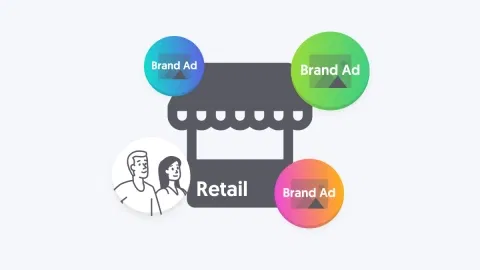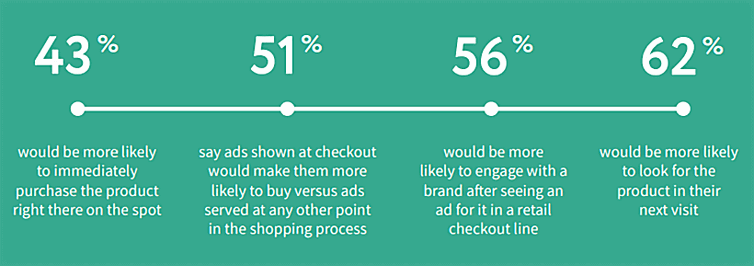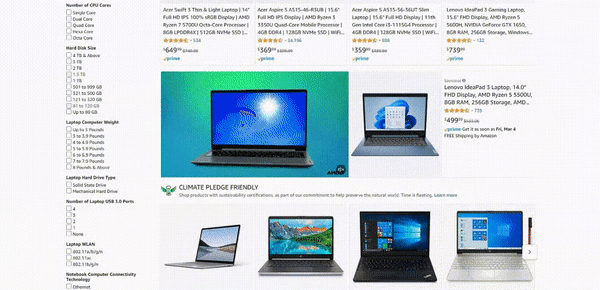
How Companies Are Monetizing with Retail Media Advertising in 2023
Despite the seemingly endless challenges that the world continues to face in recent years, one thing remains constant - people are still buying things.
Whether it’s everyday living supplies, equipment for professional applications, or devices offering convenience and entertainment, consumers haven’t gone anywhere.
And where there are consumers, there are ads.
In contrast to wholesale operations which cater to corporate purchasing needs, retail businesses are concerned with selling or reselling products to individuals.
This is where retail media advertising comes into effect.
An article by Broadsign illustrates the impact of retail ads on consumer purchasing habits when positioned near an in-store POP (point of purchase).

It should come as no surprise that similar effects are witnessed in eCommerce and online retail advertising.
In a 2021 executive summary by eMarketer, digital retail ad spending is forecasted to increase by a staggering 27.8% year over year until at least 2024.
An article titled “Why retail media is the ad industry’s sleeping giant” by TheTradeDesk provides a quotation that aptly summarizes the retail media landscape:
“The retail media space is too big to fail. It’s no longer a secondary focus for the retailers or brands. And it’s going to be one of the biggest areas of growth over the next several years.”
-Alex Johnson, VP of data and technology solutions at MediaLink
Another 2022 report by eMarketer highlights that retail media networks including Amazon, Walmart, Instacart, eBay, and Home Depot are spearheading this upward growth trend.
The good news is that while these multi-billion dollar organizations account for a sizable piece of the retail media pie, opportunities exist for retailers of all kinds to lift their revenue.
In this article, we’ll be taking a deep dive into retail media advertising, examples of its practical applications in customer journeys, and strategies for scalable implementation.
Table of Contents
- What is retail media advertising?
- Different types of retail media advertising with examples
- Benefits of Retail Media Advertising
- How to Implement Retail Media
What is retail media advertising?
Retail media advertising is the practice of marketing to consumers during the customer journey, with an emphasis on elevating buy-intent near points of sale and decision making.
While generally associated with product sales, retail media is also used by advertisers without products in situations where reaching retail audiences is desirable. Examples include credit card plans, travel deals, and local maintenance services, to name just a few.
In a digital context, the term “retail media” refers to ads which are bought (referred to as “media buying”) by advertisers, which are then served to a retailer’s eCommerce site, app, or in-store location.
The practice of retail media advertising allows brands to increase consumer exposure to their products and key marketing messages across retailers with which they’re partnered.
When dealing with product visibility and consumer awareness, the broader concept of retail advertising as a whole is sometimes also referred to as shopper marketing.
Different types of retail advertising media with examples
Many types of retail media techniques exist - some of which target websites, others which are optimized for mobile devices, and some which are used in brick and mortar locations.
In this section, we’ll cover a variety of different approaches to consumer advertising across the different mediums and platforms with which they engage.
In-store advertising
As popular as ecommerce has become, and as many challenges as physical store locations have faced since the pandemic, in-store shopping experiences are still as relevant as ever.
In-store advertising has been a part of consumer culture for as long as marketplaces have existed, and so have many of the shopper advertising techniques that are still used today.
A few examples of traditional retail media approaches used in stores include things like product displays, loyalty cards, giving away free product samples, and discount coupons.
This list of 27 in-store ads and this list of 15 in-store display ideas can both offer some creative inspiration for modern approaches to in-store advertising (plus, some of the examples are simply fun to look at, with or without a pair of marketing goggles on!).
As effective as traditional retail media is, disruption is taking place as a newer technique referred to as DOOH (Digital Out-Of-Home) experiences adoption across many brick and mortar locations.
DOOH has several practical applications for in-store media, including digital refrigeration and vending unit screens, checkout aisle displays, and overhead screen displays, to name a few.

As one example, an article by ModernRetail showcases how some companies have begun installing digital vending screens that present consumers with options at their point of decision over which item to purchase.
The effectiveness of DOOH advertising campaigns in retail environments is noticeable, with a summary by GroceryTV citing that one of their campaigns for candy bars resulted in a conversion increase of 12.5%.
Audio elements such as in-store radio are also worth consideration in some shopping environments - both for setting the atmosphere and for delivering product messaging.
In a study by Arbitron, over 40% of people who heard a retail audio ad made an unplanned purchase during their shopping session.
There’s quite a bit to consider when setting up an effective retail media strategy for an in-store location.
For further reading, a complete in-store marketing guide by Tokinomo provides an extensive deep-dive on the subject.
Featured Product Sections
A retailer’s website is their most valuable digital property for advertising - and of course, the home page is prime real-estate for featuring various products.
One of the most popular and sought after methods of product promotion involves the use of a “sponsored product” section on a retailer’s website.
Brands are able to negotiate advertising deals with the retailer to have their products placed front-and-center within the sponsored product section.

(An example of a product section on The Home Depot’s main website.)
Oftentimes, sponsored products also feature pricing discounts to attract additional attention.
Limited Time Deals
Similar to sponsored product sections, limited time deals involve a retailer featuring certain brands or individual products in a dedicated module of the website.
The advantage of this approach is the classic induction of FOMO (fear of missing out) into consumers, as an urgency to decide and act quickly is introduced.

(An example of eBay featuring the Puma brand of products with substantial pricing discounts.)
By combining pricing discounts with the necessity to act fast, the chances that the sponsored brand will see a good return on their advertising spend are high.
When a contextual alignment between the media placement and the product section exist (as shown in the example above), the likelihood of conversions taking place is even higher.
For more on the topic of contextual-based ads, check out this introduction to contextual advertising.
Related Product Sections
Related product sections are effective for providing consumers with alternative options to a specific item they’re currently browsing.
Whether someone is about to finalize the purchase of a specific item they’re looking for, or simply researching different options, related product sections can offer an authentically helpful range of selections to the customer’s decision making process.

(An example of related items for a specific product on InstaCart - labeled as “Picked For You”.)
Once again, creating contextual alignment between the suggested products and the page currently being browsed will yield the best results when using this approach.
Platform Search Results
Another technique for advertising to shoppers is serving sponsored search results in the form of native ads when shoppers enter a query into the search bar of a retailer’s platform.

(An example of the Hewlett Packard brand using Amazon’s platform to display native ads when the term “laptop” is entered into the search bar.)
Search results can be displayed at the top of the results list, amidst the other results, or even in a dedicated header section like the example above.
As usual, ensuring that the media placement is highly relevant to the entered search query will provide the highest conversion rate to brands.
Display & Video Ads
Display ads are still one of the most popular and cost effective methods of advertising online - so why not use them as a form of retail media?
Depending on the layout of a retailer’s website, there may happen to be plenty of whitespace that can be purposed towards serving brand campaign ads.

(Amazon uses the whitespace in the sidebar of their search results page to serve a display ad from Lenovo.)
Of course, while static images can be effective, videos grab even more attention in modern marketplaces.

(Amazon serves a video ad in the middle of search results alongside a companion display ad to capture attention for one of Lenovo’s laptops.)
By making strategic use of a website or app’s layout, every inch of a retailer’s digital real-estate can be optimized to serve relevant product ads to potential buyers.
While negotiations over these ad placements can take place manually, it has become a popular practice to offer self-serve advertising solutions for advertisers to manage their own ad placements without the need to interact with sales staff or ad ops teams.
Email Ads
One final piece of web property which can sometimes be overlooked by small to medium sized retailers is their email audience.
While regular newsletters about the company itself are great, serving relevant product ads to readership allows retailers to create an additional revenue stream for themselves.
More info is available on how to serve ads to an email newsletter for retailers that are interested in managing the process through a dedicated email ad serving solution.
As an extra note, because most of the retail media placement methods mentioned above rely on ad tech, it can also be beneficial to implement techniques for monetizing ad block users - particularly in the form of serving alternative content (for example, in-house ads or evergreen product promotions) when users block retail media ads in their browser.
Benefits of Retail Media Advertising
The use of retail media by brands and retailers has increased drastically over the last few years for good reason - the practice offers a wide range of impactful monetization benefits.
At a base level, brands get increased product and brand visibility, and typically experience an increase in conversions with the placement of well targeted media near points of sale.
But retail media has more to offer.
A report by Merkle reveals that there quite a few more advantages being observed by retailers and brands beyond the basics:

(Results collected from a survey condcuted by Merkel, featured in a report by the Association of National Advertisers.)
Anyone who works in proximity to marketing and sales knows that the flow of information between these two channels is critical, and 67% of brands in the consumer packaged goods (CPGs) sector seem to agree, with closed-loop reporting being their favorite benefit.
In close second comes better consumer shopping experiences, examples of which we’ve already covered in the previous section with techniques including recommended items and contextually relevant product promotions.
While building better business relationships and the ability to enhance ad creatives with dedicated services are also high on the list of benefits, the next point warrants particular attention.
Third party-cookies are set to expire in the near future, and many traditional forms of ad targeting that rely on this piece of data will cease to function without them.
While only 33% of survey participants cited first-party data and working with proprietary media platforms as their top advantage, countless reports (including a report by Merkle) have indicated that these points alone may be the biggest contributors to the latest spike of interest in retail media.
Retail media is also advantageous from an audience targeting perspective, with many platforms offering options for dayparting, geotargeting, frequency capping, search result targeting, and even local weather-based targeting.
For further reading, a compilation of research, reports, and studies by the Association of National Advertisers offers a wealth of information on subjects ranging from influencer marketing tie-ins to why non-endemic advertisers are also showing interest in retail media.
How to Implement Retail Media
For retailers interested in implementing a retail media, the decision making process generally comes down to two options: build a retail media platform, or buy one?
Buy
Many vendors focus exclusively on delivering pre-built retail media platform solutions to their clients - including companies such as Criteo, Epsilon, CitrusAd, Crealytics, PromoteIQ, and Moloco, to name just a few of the many options on the market.
For many retailers, these pre-built retail media solutions offer the right mix of benefits to sufficiently meet their needs:
- Most of these platforms provide access to their retail media network, allowing retailers to find new advertising partners to work with right away
- Some platforms offer ad agency services to assist with the management of ad campaigns
- Pre-built retail media advertising solutions can typically be deployed in a matter of days, allowing for rapid deployment
At first glance, this list of advantages are too good to pass up - but there are some less-obvious drawbacks to consider for the long term when using a pre-built retail media platform:
- Pre-built retail media platforms and their networks generally use a revenue sharing model for their pricing - which can take a serious chunk out of a retailer’s ad revenue potential
- Pre-built retail media platforms, while dedicated to their area of focus, make it very expensive or impossible to customize the solution - what you see is generally what you get
- While retail media networks are great for programmatic, they offer little to no control over creating direct media buying - a highly lucrative channel, especially post-third party cookie
- Most retail media networks don’t provide DOOH options for serving in-store ads
- Most retail media networks don’t provide options to leverage proprietary first-party data to enrich ad targeting - again, a problematic situation post-third party cookie
With so many factors weighing against the benefits of joining a pre-built retail media platform, what might an alternative be?
Build
Wouldn't building a retail media platform create an unimaginable amount of overhead?
Not necessarily.

(A sponsored product section deployed by Costco.)
The above sponsored product section is being served to Costco’s main website through a custom ad serving solution, built using an ad server API.
The full scope of work for launching the module was completed in a few weeks.
Costco’s retail platform customization took place on a month-by-month basis as consumer data was collected and new advertising opportunities were identified.
Using a custom ad serving solution to deliver retail media offers a number of benefits in direct contrast to the drawbacks of joining a pre-built retail media platform:
- Ad servers generally follow SaaS pricing, meaning that more revenue stays in the pocket of the retailer
- Many ad serving solutions have pre-built functionalities, which can completely eliminate development time for some use-cases
- Custom ad serving APIs allow customizations to be made easily by in-house and service provider development teams
- Ad servers are generally capable of serving DOOH ads, including in-store ads
- Ad servers can act as a demand-neutral SSP solution for serving programmatic ads
- Ad servers are perfect for managing direct deals with advertising partners
- Ad servers allow first-party data to be leveraged to enrich ad targeting
To offset this list, the only thing an ad serving solution won’t come with is a network of advertising demand sources - though proprietary lists of advertising partners, as well as third-party demand sources like ad networks can be easily conncted to the platform.
So, what’s the best way to implement retail media?
For small to medium retailers that need to connect with a large number of programmatic advertisers quickly, joining a pre-built retail media platform and network might do the trick.
For just about any other retailer, the long-term revenue lift offered by directly owning a retail media ad serving platform far exceeds the short-term advantages of joining a third-party platform and network.
In addition, as covered earlier, 29% of brands value working with partners that have proprietary control of their retail media platforms over all other benefits offered by retail media.
Gaining true ownership of retail media in your business
Retailers and the brands they work with stand to gain more than ever before by implementing an effective retail media advertising strategy.
During your sourcing process, we encourage you to explore AdButler - an ad serving solution that offers everything a retailer could ask for in their media platform:
- A well-documented and easy-to-use ad serving API
- Complete support for every ad format (display, video, audio, native, sponsored listings, etc.)
- A self-serve marketplace portal for automating direct deals with advertising partners
- A supply-side programmatic solution that guarantees complete data privacy and control
- First-party data contextualization to increase ad relevance across entire web properties
- An email ad server for monetizing consumer mailing lists
- Custom development for any extras you or your advertising partners may need
- Custom reports that make optimizations easy and performance simple to share with brand partners
The AdButler team has over two decades of experience in providing and configuring ad serving solutions for both publishers and advertisers.
We’d love to share a conversation with you. Ask us a question today!